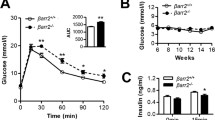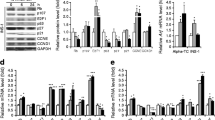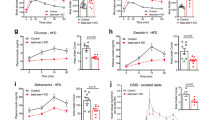Abstract
Beta cell replication is the major component for maintenance of beta cell mass in adult rodents; however, little is known about what is the earliest signals that initiate rodent beta cell proliferation. The mTORC1 pathway integrates signals from growth factors and nutrients and regulates cell growth and survival. Here, we used normoglycemic 60 % partial-pancreatectomy (60 % Px) mouse model to determine whether mTORC1 pathway was required for compensatory beta cell proliferation. C57BL/6 J male mice were subjected to 60 % Px or sham operation, and subsequently treated with either rapamycin or vehicle for 7 days. Metabolic profile, pancreatic beta cell mass, and proliferation were examined, and expression levels of cell cycle regulators were determined. Beta cell proliferation was increased by 2.5-fold, and mTORC1 signaling was activated in islets post-Px. Rapamycin treatment impaired glucose tolerance and glucose stimulating insulin secretion in 60 % Px mice, but did not affect their insulin sensitivity in peripheral tissue. Rapamycin inhibited mTORC1 activity in beta cells, suppressed compensatory beta cell proliferation and growth, and reduced beta cell mass and insulin content in 60 % Px mice. Px caused an increase of the cyclin D2 at protein level and promoted cyclin D2 nuclear localization in an mTOR-dependent manner. Disrupting mTORC1 signaling suppressed cell proliferation and simultaneously diminished cyclin D2 protein abundance in RINm5F cells. Our data demonstrated that mTORC1 plays an essential role in beta cell adaption to significant beta cell mass loss in 60 % Px model and in early compensatory beta cell proliferation via cyclin D2 pathway.





Similar content being viewed by others
References
M. Karaca, C. Magnan, C. Kargar, Functional pancreatic beta-cell mass: involvement in type 2 diabetes and therapeutic intervention. Diabetes Metab. 35(2), 77–84 (2009). doi:10.1016/j.diabet.2008.09.007
M.O. Larsen, Beta-cell function and mass in type 2 diabetes. Dan. Med. Bull. 56(3), 153–164 (2009)
A.V. Matveyenko, P.C. Butler, Relationship between beta-cell mass and diabetes onset. Diabetes Obes. Metab. 10(Suppl 4), 23–31 (2008). doi:10.1111/j.1463-1326.2008.00939.x
J.J. Meier, R.C. Bonadonna, Role of reduced beta-cell mass versus impaired beta-cell function in the pathogenesis of type 2 diabetes. Diabetes Care 36(Suppl 2), S113–S119 (2013). doi:10.2337/dcS13-2008
G.C. Weir, S. Bonner-Weir, Islet beta cell mass in diabetes and how it relates to function, birth, and death. Ann. N. Y. Acad. Sci. 1281, 92–105 (2013). doi:10.1111/nyas.12031
D. Pipeleers, M. Chintinne, B. Denys, G. Martens, B. Keymeulen, F. Gorus, Restoring a functional beta-cell mass in diabetes. Diabetes Obes. Metab. 10(Suppl 4), 54–62 (2008). doi:10.1111/j.1463-1326.2008.00941.x
C.J. Rhodes, Type 2 diabetes-a matter of beta-cell life and death? Science 307(5708), 380–384 (2005). doi:10.1126/science.1104345
Y. Dor, J. Brown, O.I. Martinez, D.A. Melton, Adult pancreatic beta-cells are formed by self-duplication rather than stem-cell differentiation. Nature 429(6987), 41–46 (2004). doi:10.1038/nature02520
S. Georgia, A. Bhushan, Beta cell replication is the primary mechanism for maintaining postnatal beta cell mass. J. Clin. Invest. 114(7), 963–968 (2004). doi:10.1172/jci22098
M. Laplante, D.M. Sabatini, mTOR signaling at a glance. J. Cell Sci. 122(Pt 20), 3589–3594 (2009). doi:10.1242/jcs.051011
J.J. Howell, B.D. Manning, mTOR couples cellular nutrient sensing to organismal metabolic homeostasis. Trends Endocrinol. Metab. 22(3), 94–102 (2011). doi:10.1016/j.tem.2010.12.003
S.C. Johnson, P.S. Rabinovitch, M. Kaeberlein, mTOR is a key modulator of ageing and age-related disease. Nature 493(7432), 338–345 (2013). doi:10.1038/nature11861
M. Shimobayashi, M.N. Hall, Making new contacts: the mTOR network in metabolism and signalling crosstalk. Nat. Rev. Mol. Cell Biol. 15(3), 155–162 (2014). doi:10.1038/nrm3757
M. Blandino-Rosano, A.Y. Chen, J.O. Scheys, E.U. Alejandro, A.P. Gould, T. Taranukha, L. Elghazi, C. Cras-Meneur, E. Bernal-Mizrachi, mTORC1 signaling and regulation of pancreatic beta-cell mass. Cell Cycle 11(10), 1892–1902 (2012). doi:10.4161/cc.20036
A.D. Barlow, M.L. Nicholson, T.P. Herbert, Evidence for rapamycin toxicity in pancreatic beta-cells and a review of the underlying molecular mechanisms. Diabetes 62(8), 2674–2682 (2013). doi:10.2337/db13-0106
B.W. Paty, J.S. Harmon, C.L. Marsh, R.P. Robertson, Inhibitory effects of immunosuppressive drugs on insulin secretion from HIT-T15 cells and Wistar rat islets. Transplantation 73(3), 353–357 (2002)
E. Bell, X. Cao, J.A. Moibi, S.R. Greene, R. Young, M. Trucco, Z. Gao, F.M. Matschinsky, S. Deng, J.F. Markman, A. Naji, B.A. Wolf, Rapamycin has a deleterious effect on MIN-6 cells and rat and human islets. Diabetes 52(11), 2731–2739 (2003)
L. Rachdi, N. Balcazar, F. Osorio-Duque, L. Elghazi, A. Weiss, A. Gould, K.J. Chang-Chen, M.J. Gambello, E. Bernal-Mizrachi, Disruption of Tsc2 in pancreatic beta cells induces beta cell mass expansion and improved glucose tolerance in a TORC1-dependent manner. Proc. Natl. Acad. Sci. USA 105(27), 9250–9255 (2008). doi:10.1073/pnas.0803047105
H. Mori, K. Inoki, D. Opland, H. Munzberg, E.C. Villanueva, M. Faouzi, T. Ikenoue, D.J. Kwiatkowski, O.A. Macdougald, M.G. Myers Jr, K.L. Guan, Critical roles for the TSC-mTOR pathway in beta-cell function. Am. J. Physiol. Endocrinol. Metab. 297(5), E1013–E1022 (2009). doi:10.1152/ajpendo.00262.2009
S. Hamada, K. Hara, T. Hamada, H. Yasuda, H. Moriyama, R. Nakayama, M. Nagata, K. Yokono, Upregulation of the mammalian target of rapamycin complex 1 pathway by Ras homolog enriched in brain in pancreatic beta-cells leads to increased beta-cell mass and prevention of hyperglycemia. Diabetes 58(6), 1321–1332 (2009). doi:10.2337/db08-0519
M. Pende, S.H. Um, V. Mieulet, M. Sticker, V.L. Goss, J. Mestan, M. Mueller, S. Fumagalli, S.C. Kozma, G. Thomas, S6K1(-/-)/S6K2(-/-) mice exhibit perinatal lethality and rapamycin-sensitive 5’-terminal oligopyrimidine mRNA translation and reveal a mitogen-activated protein kinase-dependent S6 kinase pathway. Mol. Cell. Biol. 24(8), 3112–3124 (2004)
I. Ruvinsky, N. Sharon, T. Lerer, H. Cohen, M. Stolovich-Rain, T. Nir, Y. Dor, P. Zisman, O. Meyuhas, Ribosomal protein S6 phosphorylation is a determinant of cell size and glucose homeostasis. Genes Dev. 19(18), 2199–2211 (2005). doi:10.1101/gad.351605
M. Pende, S.C. Kozma, M. Jaquet, V. Oorschot, R. Burcelin, Y. Le Marchand-Brustel, J. Klumperman, B. Thorens, G. Thomas, Hypoinsulinaemia, glucose intolerance and diminished beta-cell size in S6K1-deficient mice. Nature 408(6815), 994–997 (2000). doi:10.1038/35050135
N. Niclauss, D. Bosco, P. Morel, L. Giovannoni, T. Berney, G. Parnaud, Rapamycin impairs proliferation of transplanted islet beta cells. Transplantation 91(7), 714–722 (2011). doi:10.1097/TP.0b013e31820c10c8
C.T. Bussiere, J.R. Lakey, A.M. Shapiro, G.S. Korbutt, The impact of the mTOR inhibitor sirolimus on the proliferation and function of pancreatic islets and ductal cells. Diabetologia 49(10), 2341–2349 (2006). doi:10.1007/s00125-006-0374-5
M. Fraenkel, M. Ketzinel-Gilad, Y. Ariav, O. Pappo, M. Karaca, J. Castel, M.F. Berthault, C. Magnan, E. Cerasi, N. Kaiser, G. Leibowitz, mTOR inhibition by rapamycin prevents beta-cell adaptation to hyperglycemia and exacerbates the metabolic state in type 2 diabetes. Diabetes 57(4), 945–957 (2008). doi:10.2337/db07-0922
E. Zahr, R.D. Molano, A. Pileggi, H. Ichii, S.S. Jose, N. Bocca, W. An, J. Gonzalez-Quintana, C. Fraker, C. Ricordi, L. Inverardi, Rapamycin impairs in vivo proliferation of islet beta-cells. Transplantation 84(12), 1576–1583 (2007). doi:10.1097/01.tp.0000296035.48728.28
V.P. Houde, S. Brule, W.T. Festuccia, P.G. Blanchard, K. Bellmann, Y. Deshaies, A. Marette, Chronic rapamycin treatment causes glucose intolerance and hyperlipidemia by upregulating hepatic gluconeogenesis and impairing lipid deposition in adipose tissue. Diabetes 59(6), 1338–1348 (2010). doi:10.2337/db09-1324
S.B. Yang, H.Y. Lee, D.M. Young, A.C. Tien, A. Rowson-Baldwin, Y.Y. Shu, Y.N. Jan, L.Y. Jan, Rapamycin induces glucose intolerance in mice by reducing islet mass, insulin content, and insulin sensitivity. J. Mol. Med. (Berl) 90(5), 575–585 (2012). doi:10.1007/s00109-011-0834-3
A.A. Misfeldt, R.H. Costa, M. Gannon, Beta-cell proliferation, but not neogenesis, following 60 % partial pancreatectomy is impaired in the absence of FoxM1. Diabetes 57(11), 3069–3077 (2008). doi:10.2337/db08-0878
M. Peshavaria, B.L. Larmie, J. Lausier, B. Satish, A. Habibovic, V. Roskens, K. Larock, B. Everill, J.L. Leahy, T.L. Jetton, Regulation of pancreatic beta-cell regeneration in the normoglycemic 60 % partial-pancreatectomy mouse. Diabetes 55(12), 3289–3298 (2006). doi:10.2337/db06-0017
D.D. De Leon, S. Deng, R. Madani, R.S. Ahima, D.J. Drucker, D.A. Stoffers, Role of endogenous glucagon-like peptide-1 in islet regeneration after partial pancreatectomy. Diabetes 52(2), 365–371 (2003)
Y. Gu, J. Lindner, A. Kumar, W. Yuan, M.A. Magnuson, Rictor/mTORC2 is essential for maintaining a balance between beta-cell proliferation and cell size. Diabetes 60(3), 827–837 (2011). doi:10.2337/db10-1194
S.H. Um, M. Sticker-Jantscheff, G.C. Chau, K. Vintersten, M. Mueller, Y.G. Gangloff, R.H. Adams, J.F. Spetz, L. Elghazi, P.T. Pfluger, M. Pende, E. Bernal-Mizrachi, A. Tauler, M.H. Tschop, G. Thomas, S.C. Kozma, S6K1 controls pancreatic beta cell size independently of intrauterine growth restriction. J. Clin. Invest. 125(7), 2736–2747 (2015). doi:10.1172/jci77030
D. Baetens, F. Malaisse-Lagae, A. Perrelet, L. Orci, Endocrine pancreas: three-dimensional reconstruction shows two types of islets of langerhans. Science 206(4424), 1323–1325 (1979)
E.R. Trimble, P.A. Halban, C.B. Wollheim, A.E. Renold, Functional differences between rat islets of ventral and dorsal pancreatic origin. J. Clin. Invest. 69(2), 405–413 (1982)
G. Kilimnik, J. Jo, V. Periwal, M.C. Zielinski, M. Hara, Quantification of islet size and architecture. Islets 4(2), 167–172 (2012). doi:10.4161/isl.19256
N. Balcazar, A. Sathyamurthy, L. Elghazi, A. Gould, A. Weiss, I. Shiojima, K. Walsh, E. Bernal-Mizrachi, mTORC1 activation regulates beta-cell mass and proliferation by modulation of cyclin D2 synthesis and stability. J. Biol. Chem. 284(12), 7832–7842 (2009). doi:10.1074/jbc.M807458200
M. Prentki, C.J. Nolan, Islet beta cell failure in type 2 diabetes. J. Clin. Invest. 116(7), 1802–1812 (2006). doi:10.1172/jci29103
E.U. Alejandro, B. Gregg, M. Blandino-Rosano, C. Cras-Meneur, E. Bernal-Mizrachi, Natural history of beta-cell adaptation and failure in type 2 diabetes. Mol. Aspects Med. (2014). doi:10.1016/j.mam.2014.12.002
S. Rieck, K.H. Kaestner, Expansion of beta-cell mass in response to pregnancy. Trends Endocrinol. Metab. 21(3), 151–158 (2010). doi:10.1016/j.tem.2009.11.001
S. Chen, M. Shimoda, J. Chen, S. Matsumoto, P.A. Grayburn, Transient overexpression of cyclin D2/CDK4/GLP1 genes induces proliferation and differentiation of adult pancreatic progenitors and mediates islet regeneration. Cell Cycle 11(4), 695–705 (2012). doi:10.4161/cc.11.4.19120
S.J. Salpeter, A. Klochendler, N. Weinberg-Corem, S. Porat, Z. Granot, A.M. Shapiro, M.A. Magnuson, A. Eden, J. Grimsby, B. Glaser, Y. Dor, Glucose regulates cyclin D2 expression in quiescent and replicating pancreatic beta-cells through glycolysis and calcium channels. Endocrinology 152(7), 2589–2598 (2011). doi:10.1210/en.2010-1372
J.A. Kushner, M.A. Ciemerych, E. Sicinska, L.M. Wartschow, M. Teta, S.Y. Long, P. Sicinski, M.F. White, Cyclins D2 and D1 are essential for postnatal pancreatic beta-cell growth. Mol. Cell. Biol. 25(9), 3752–3762 (2005). doi:10.1128/mcb.25.9.3752-3762.2005
R.E. Stamateris, R.B. Sharma, D.A. Hollern, L.C. Alonso, Adaptive beta-cell proliferation increases early in high-fat feeding in mice, concurrent with metabolic changes, with induction of islet cyclin D2 expression. Am. J. Physiol. Endocrinol. Metab. 305(1), E149–E159 (2013). doi:10.1152/ajpendo.00040.2013
M.C. Fabian, J.R. Lakey, R.V. Rajotte, N.M. Kneteman, The efficacy and toxicity of rapamycin in murine islet transplantation. In vitro and in vivo studies. Transplantation 56(5), 1137–1142 (1993)
N. Zhang, D. Su, S. Qu, T. Tse, R. Bottino, A.N. Balamurugan, J. Xu, J.S. Bromberg, H.H. Dong, Sirolimus is associated with reduced islet engraftment and impaired beta-cell function. Diabetes 55(9), 2429–2436 (2006). doi:10.2337/db06-0173
S. Di Paolo, A. Teutonico, D. Leogrande, C. Capobianco, P.F. Schena, Chronic inhibition of mammalian target of rapamycin signaling downregulates insulin receptor substrates 1 and 2 and AKT activation: A crossroad between cancer and diabetes? J. Am. Soc. Nephrol. 17(8), 2236–2244 (2006). doi:10.1681/asn.2006030196
A.Y. Choo, J. Blenis, Not all substrates are treated equally: implications for mTOR, rapamycin-resistance and cancer therapy. Cell Cycle 8(4), 567–572 (2009)
Acknowledgments
We are grateful to Mrs Yun Liu, Dr Qinglei Yin, Dr Yun Xie, Dr Binbing Guan, and Dr Xiu Luo for theirs help during islet isolation. This work was supported by National Natural Sciences Foundation of China Grants (81200565, 81270860, 81370875, 81200563, 81390350).
Author contribution
W.L and Q.W researched data, wrote the manuscript, contributed to discussion, and reviewed/edited the manuscript. Y.G researched data and reviewed/edited the manuscript. H.Z, F.L, Q.N, and A.N researched data and contributed to discussion. G.N and X.L contributed to discussion and reviewed/edited the manuscript.
Author information
Authors and Affiliations
Corresponding author
Ethics declarations
Conflict of Interest
The authors declare that they have no conflict of interest.
Additional information
Wenyi li and Hongli Zhang have contributed equally to this paper.
Rights and permissions
About this article
Cite this article
li, W., Zhang, H., Nie, A. et al. mTORC1 pathway mediates beta cell compensatory proliferation in 60 % partial-pancreatectomy mice. Endocrine 53, 117–128 (2016). https://doi.org/10.1007/s12020-016-0861-5
Received:
Accepted:
Published:
Issue Date:
DOI: https://doi.org/10.1007/s12020-016-0861-5




